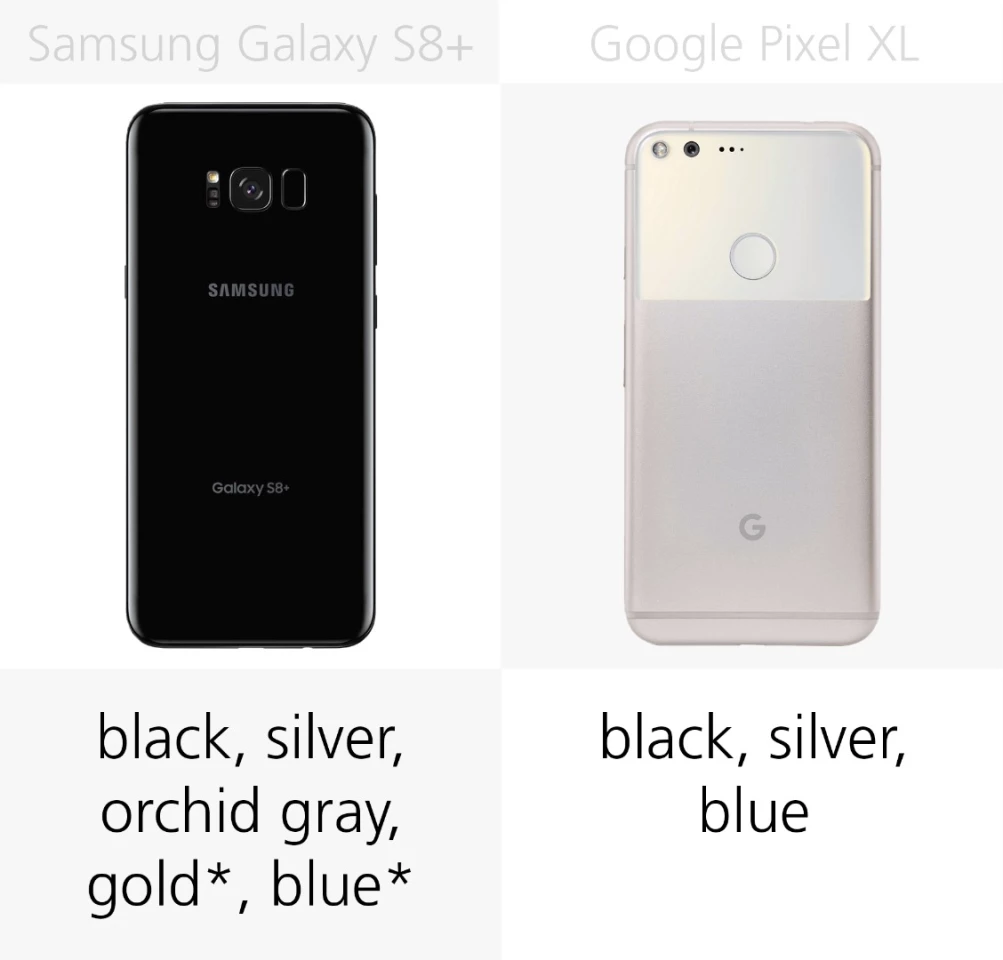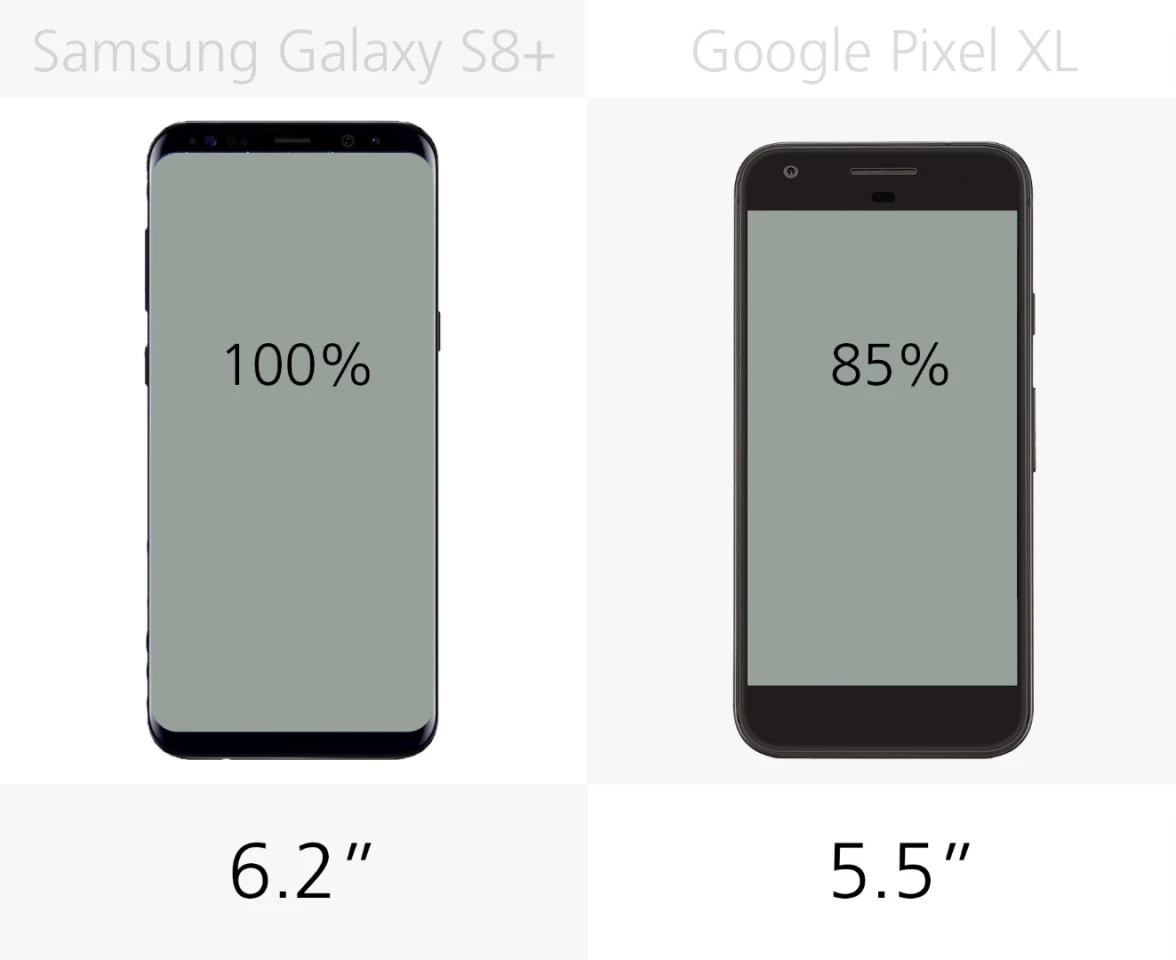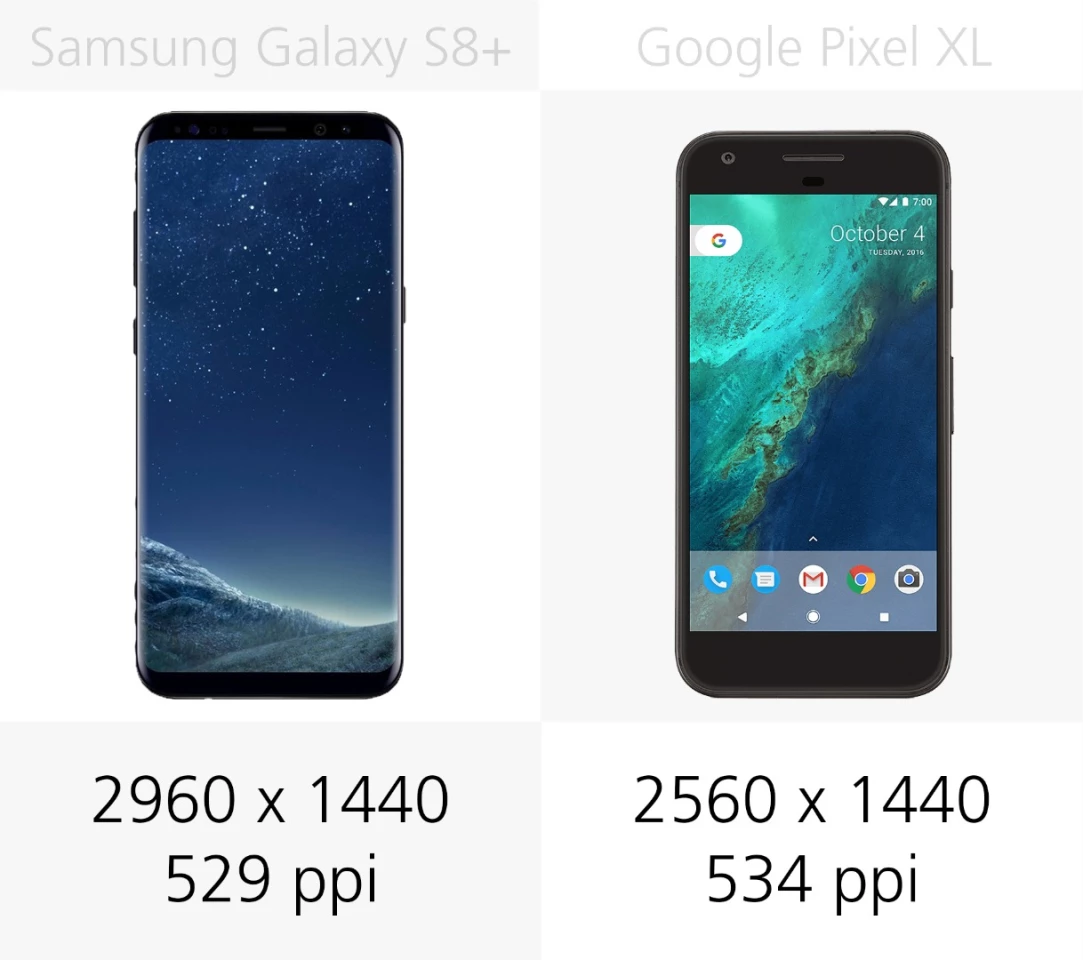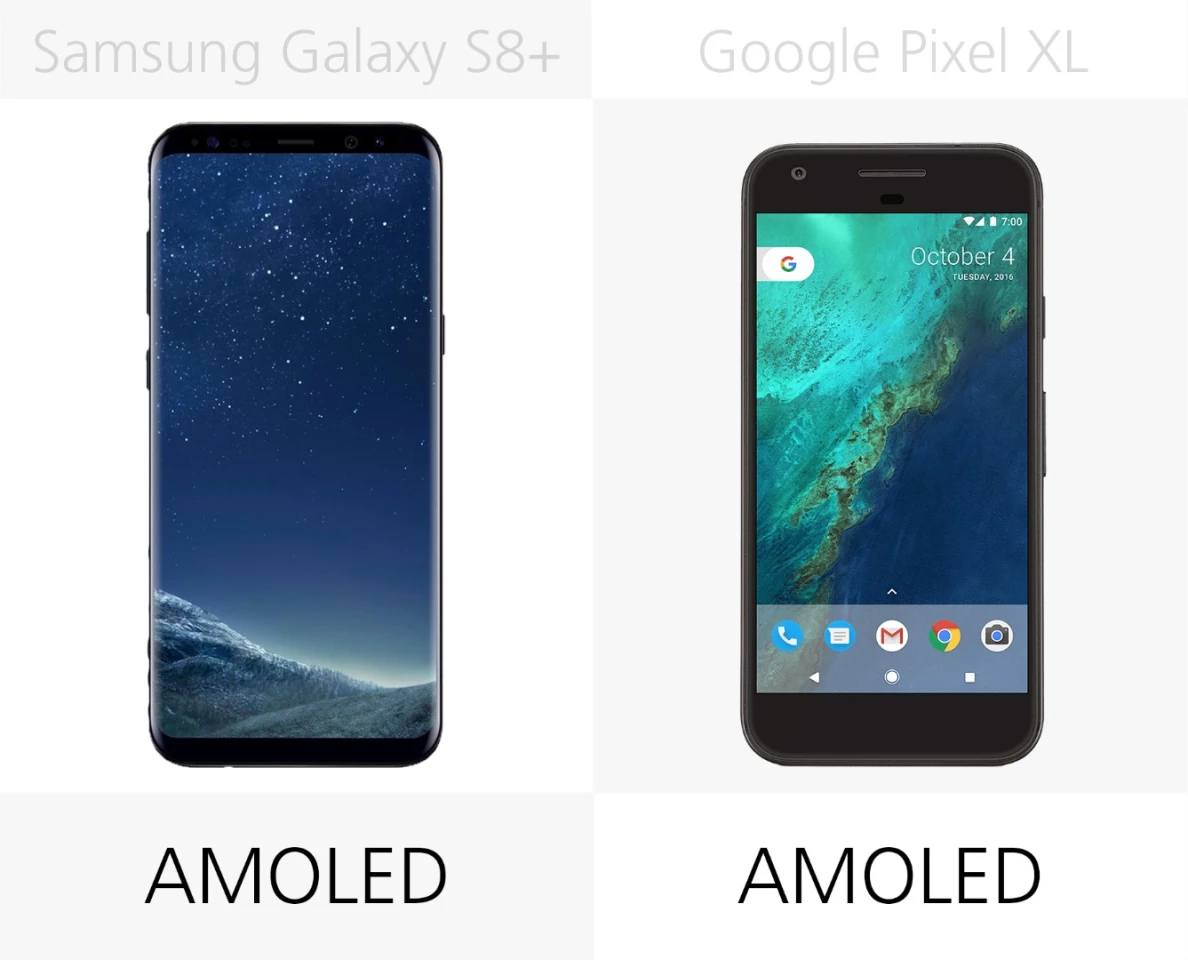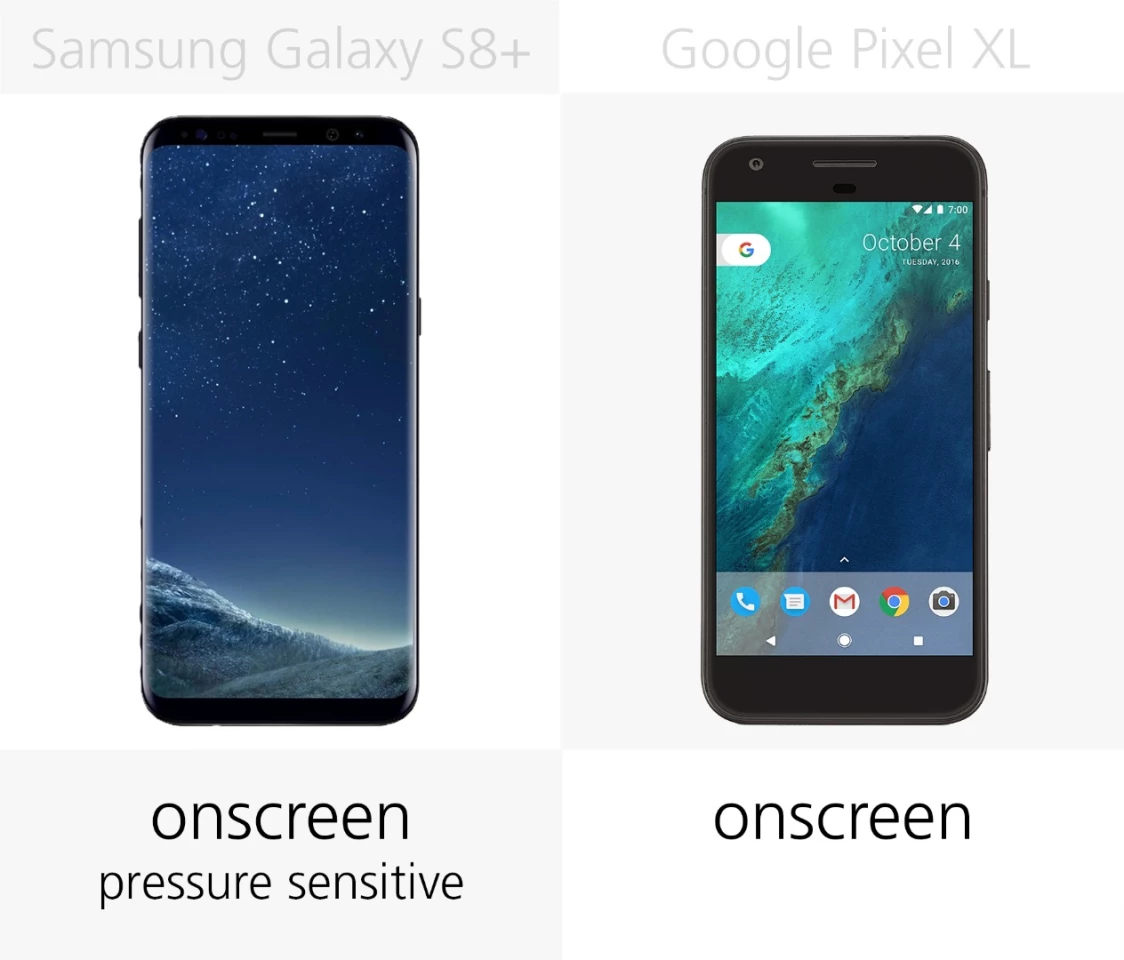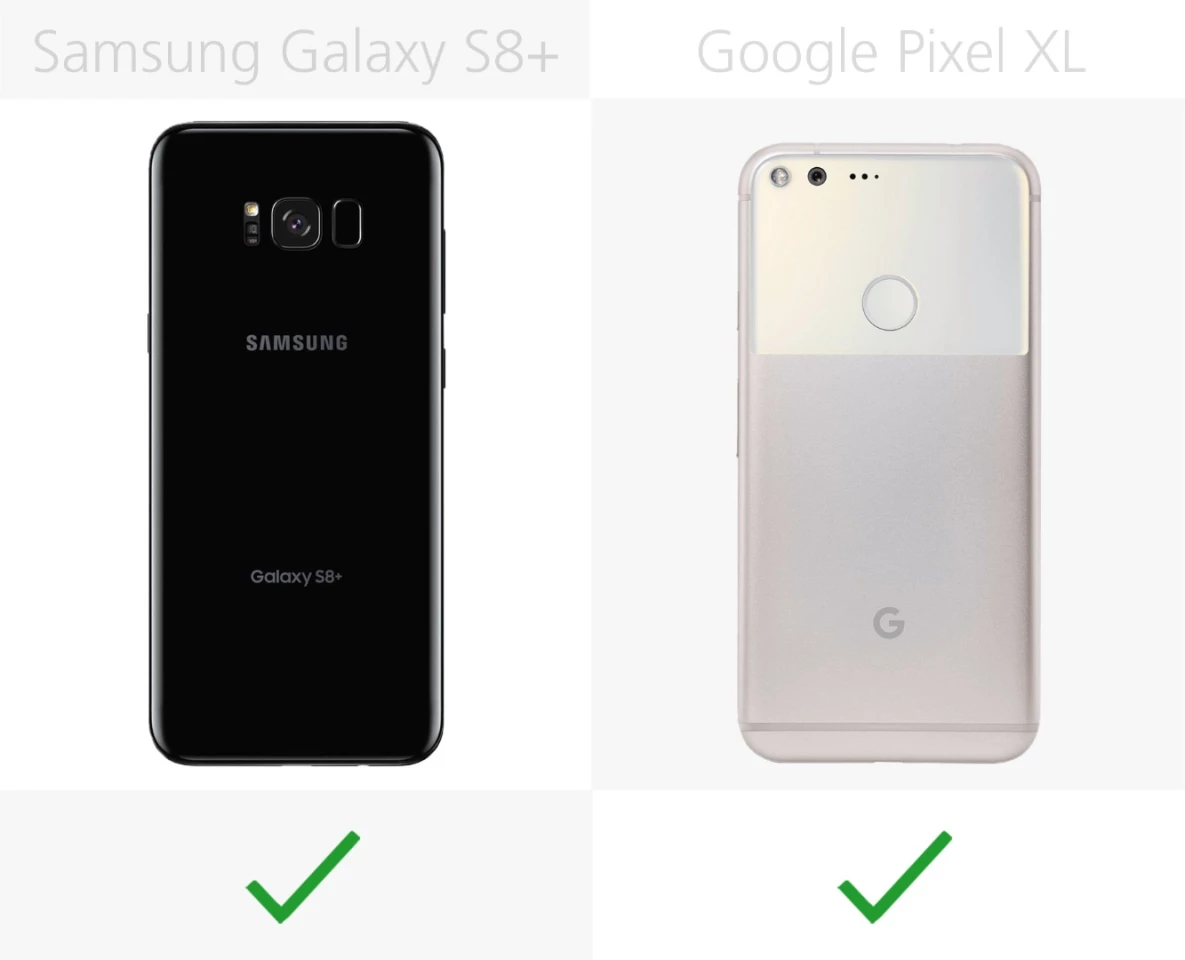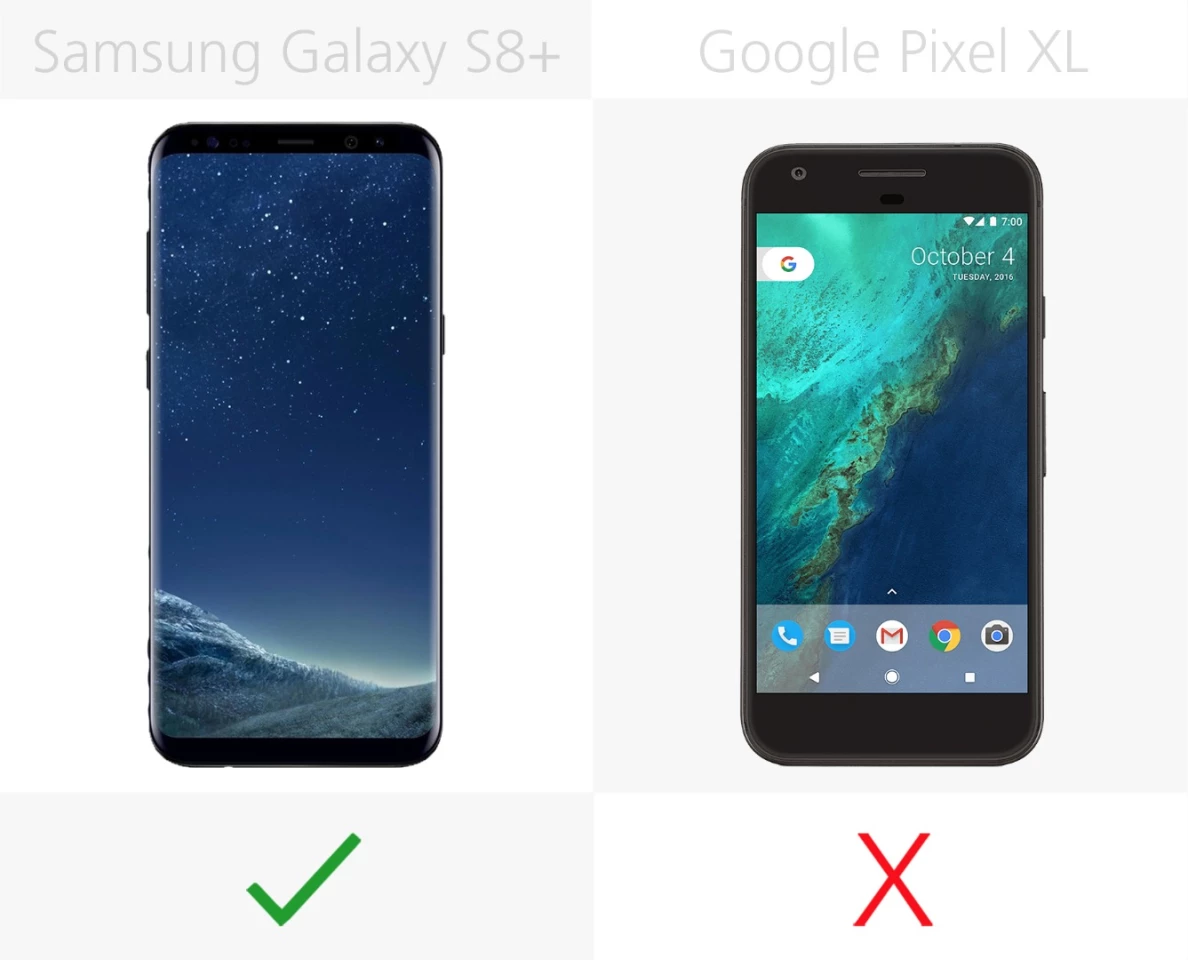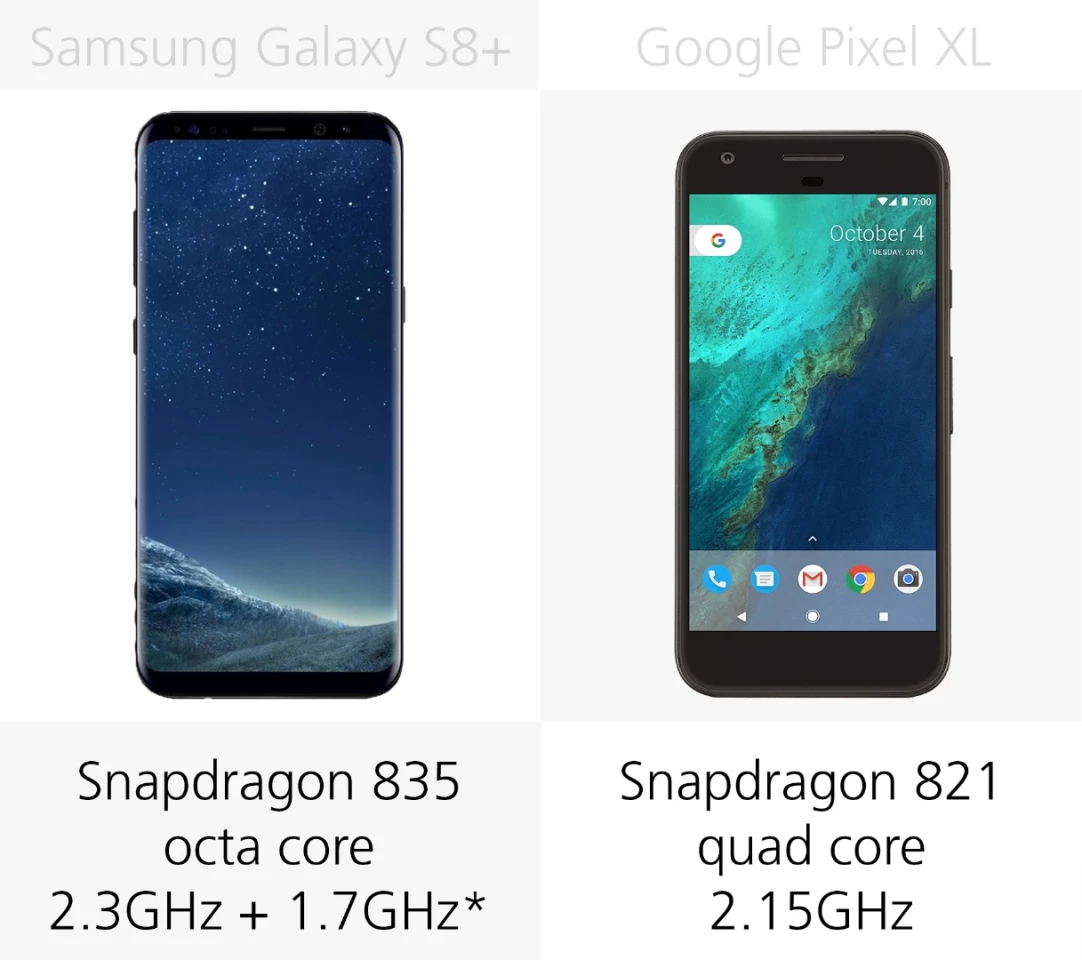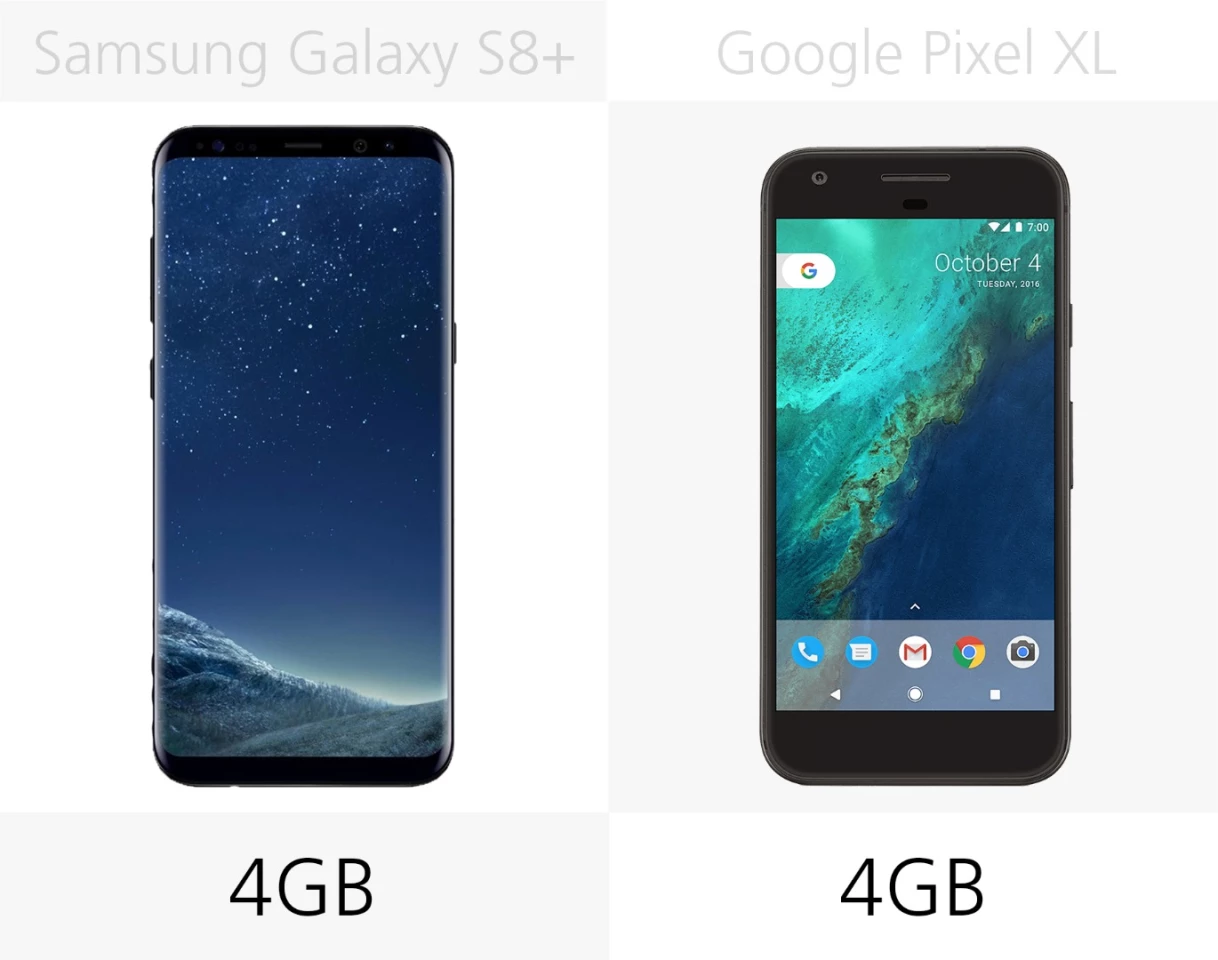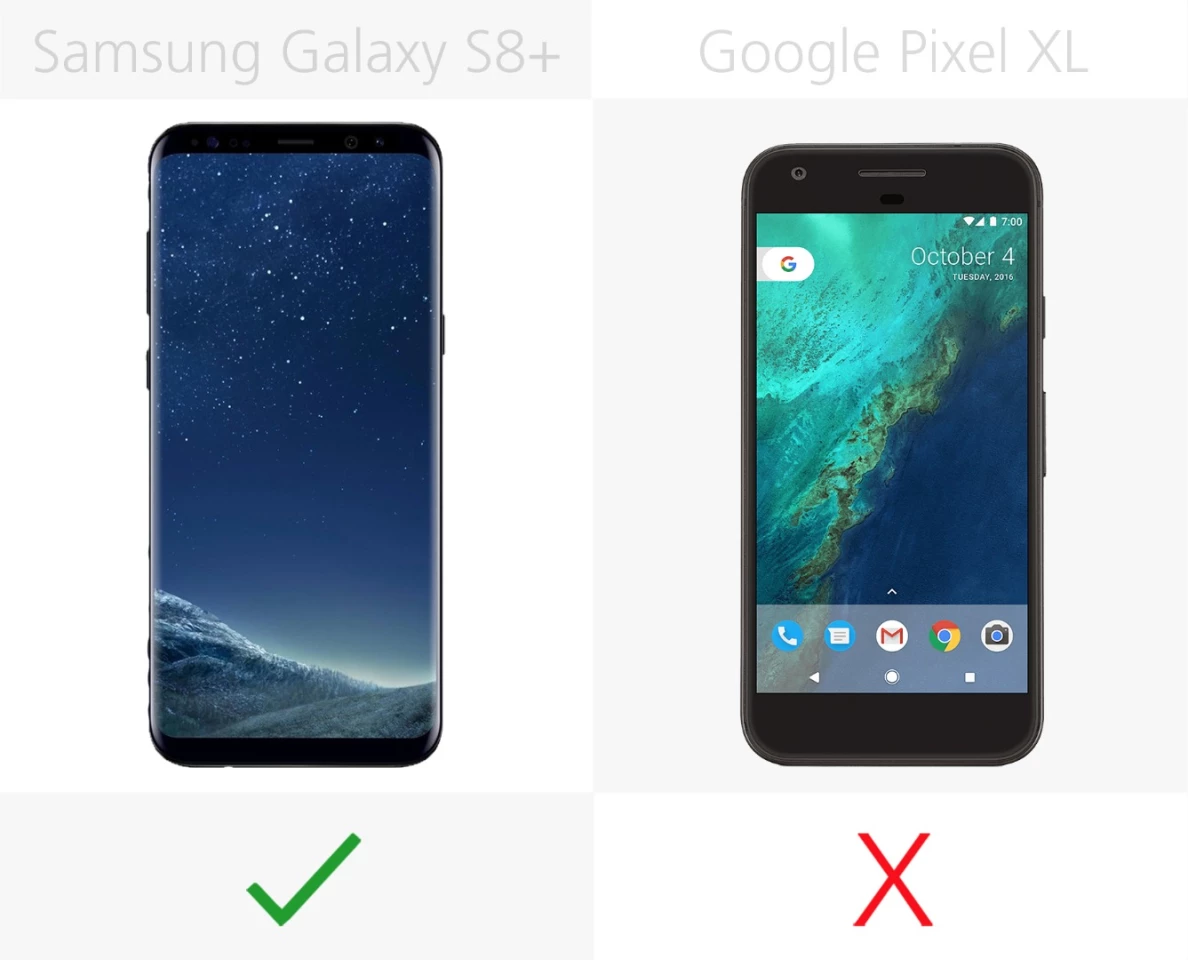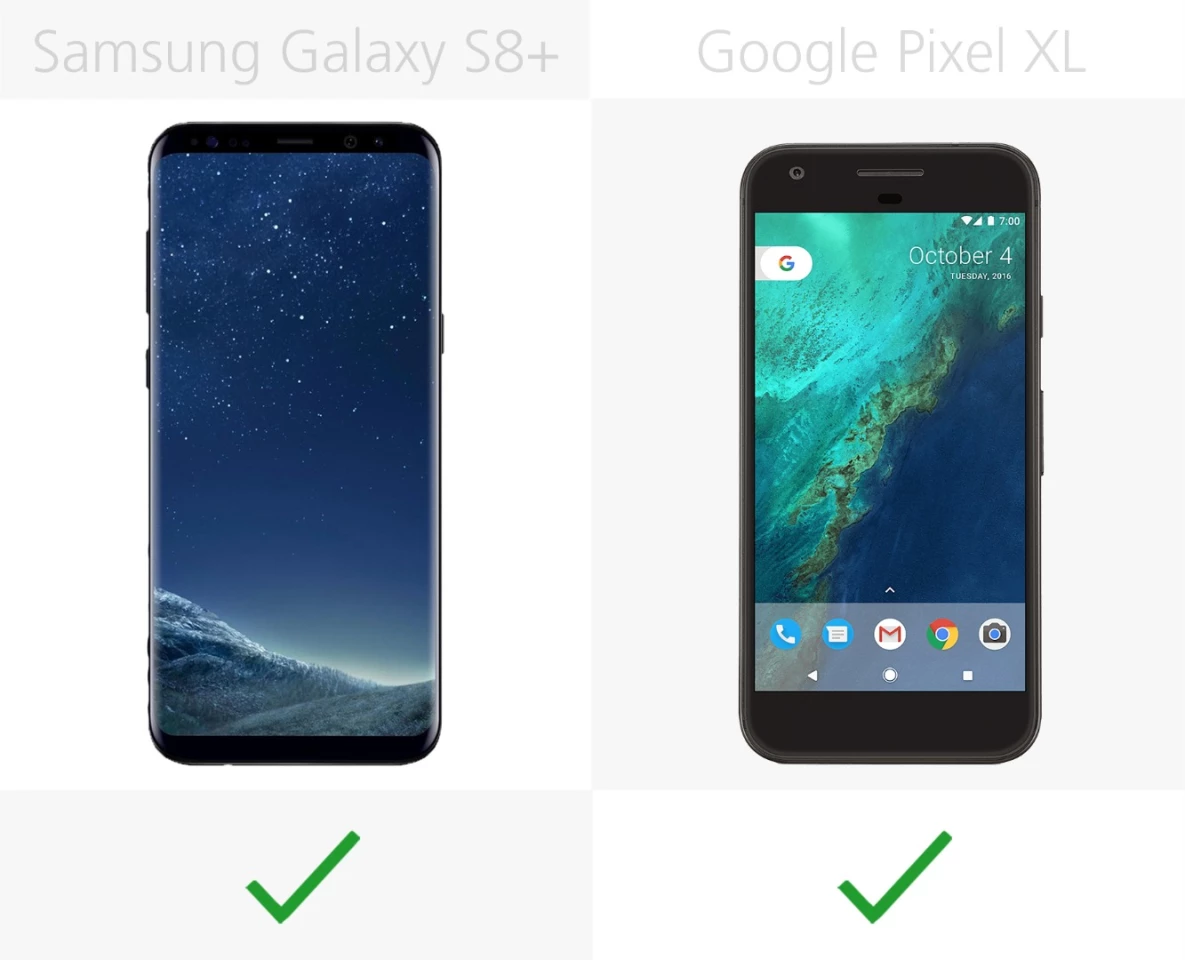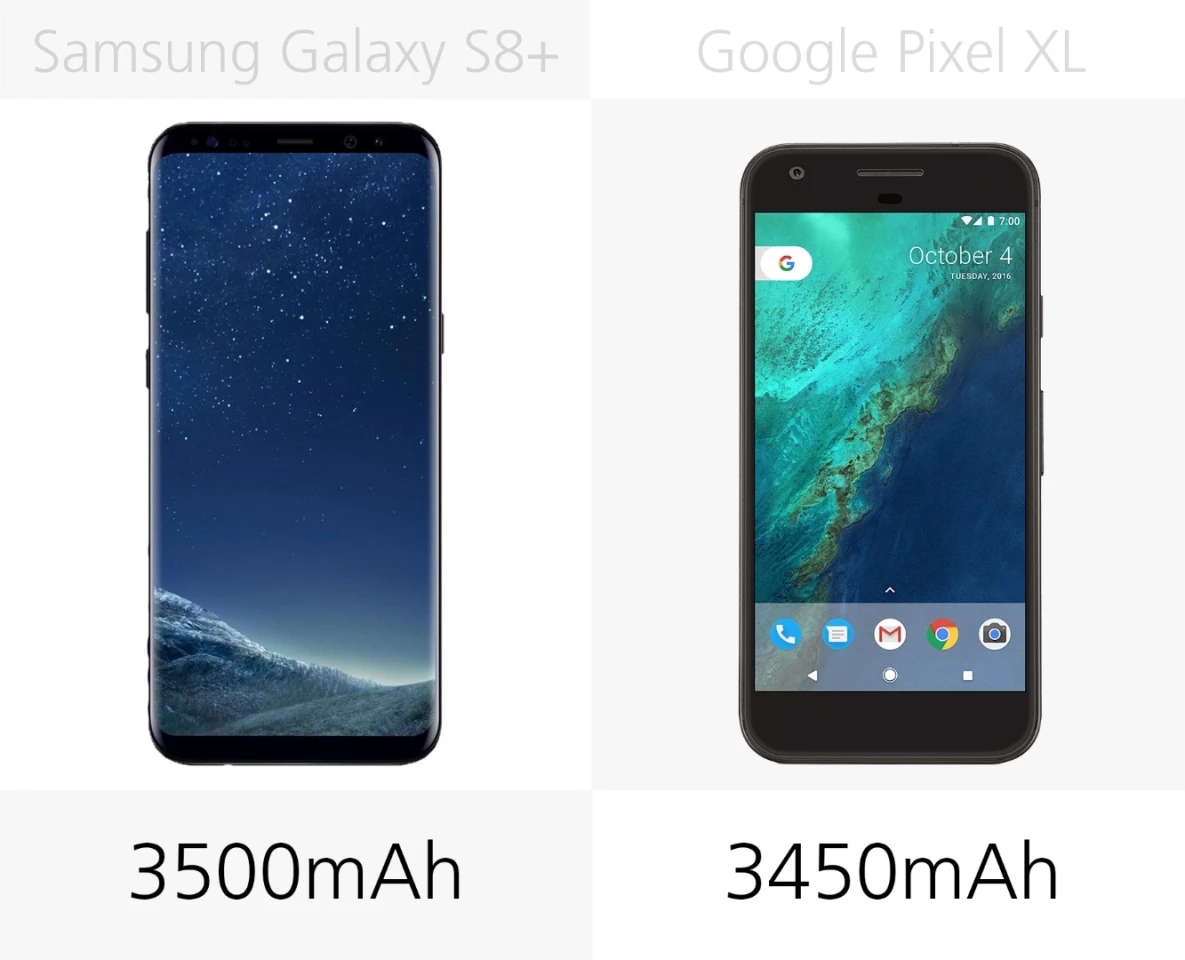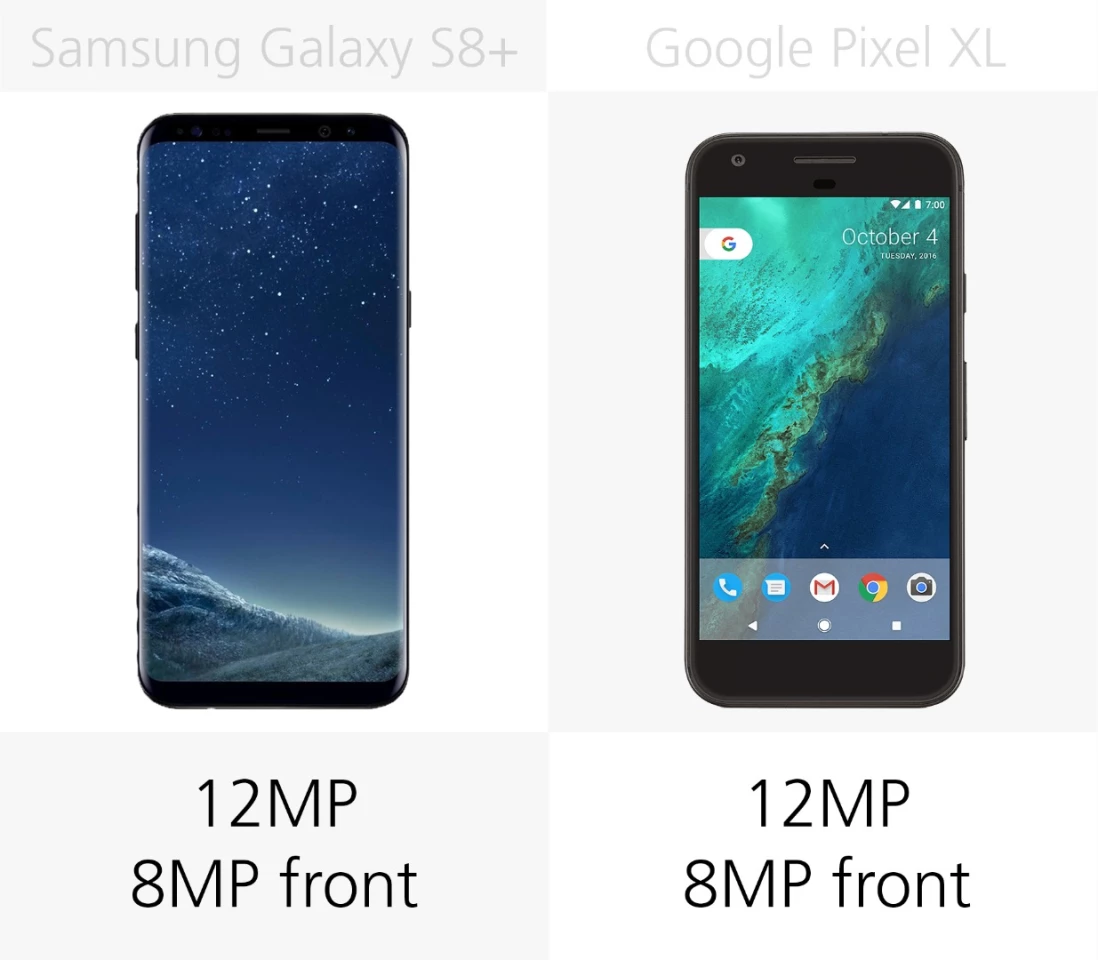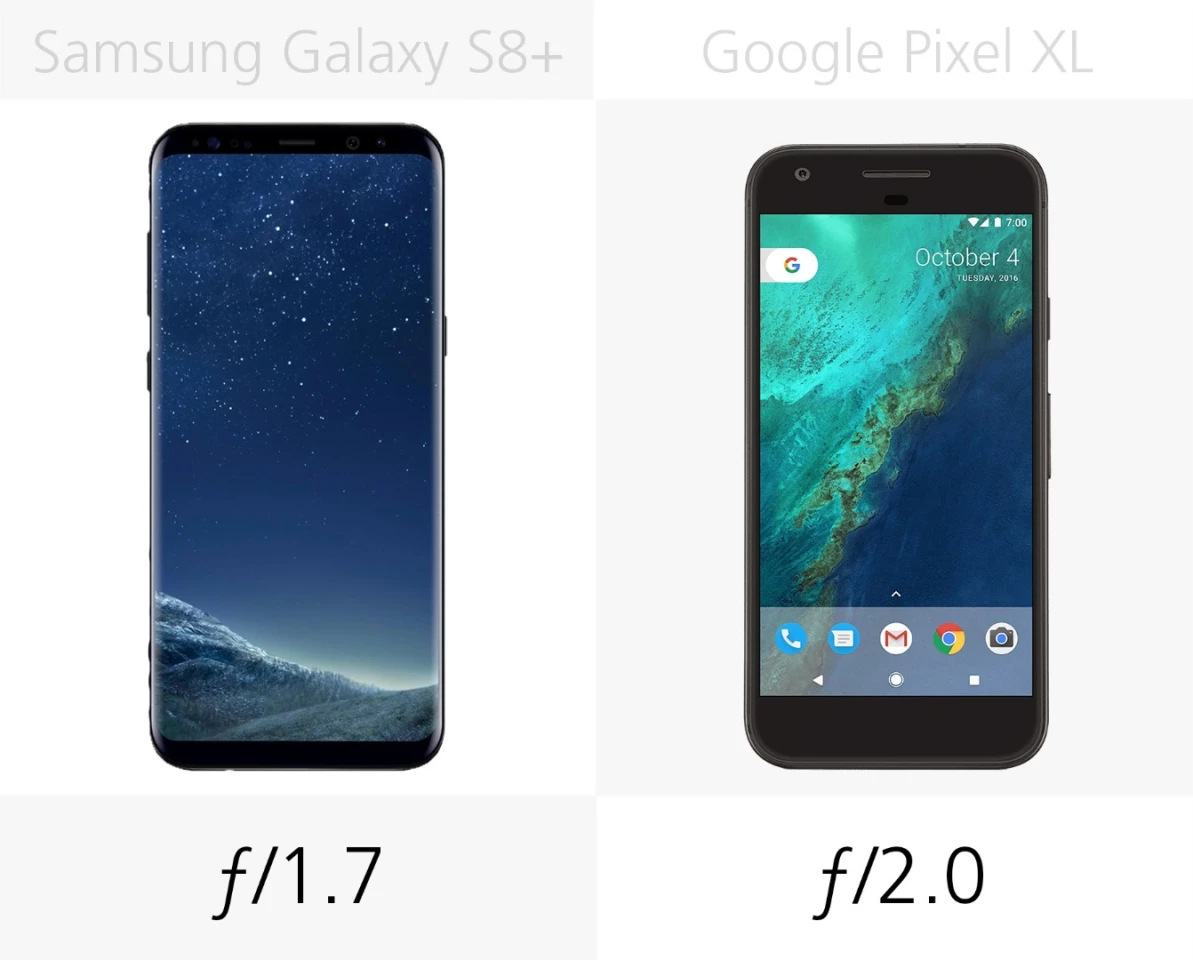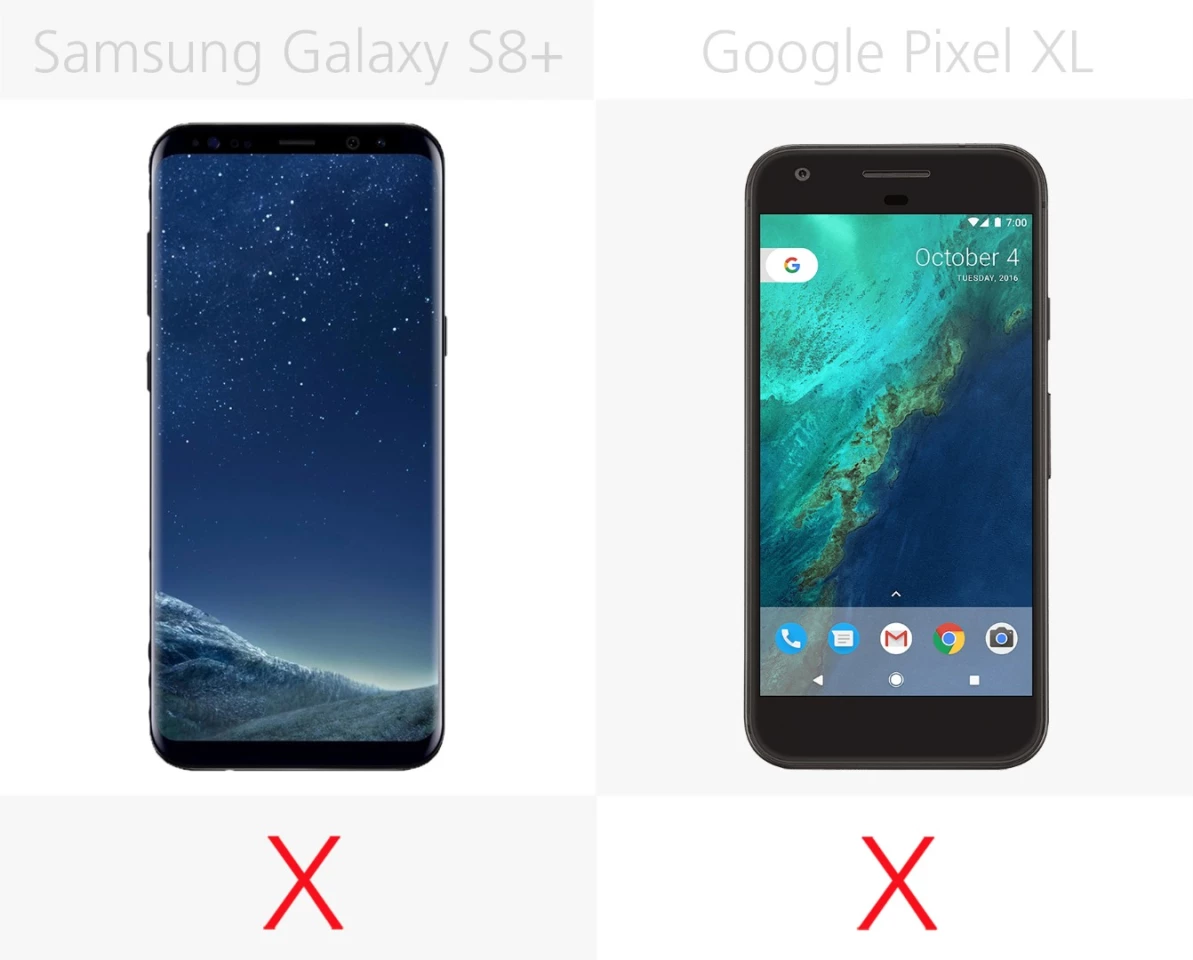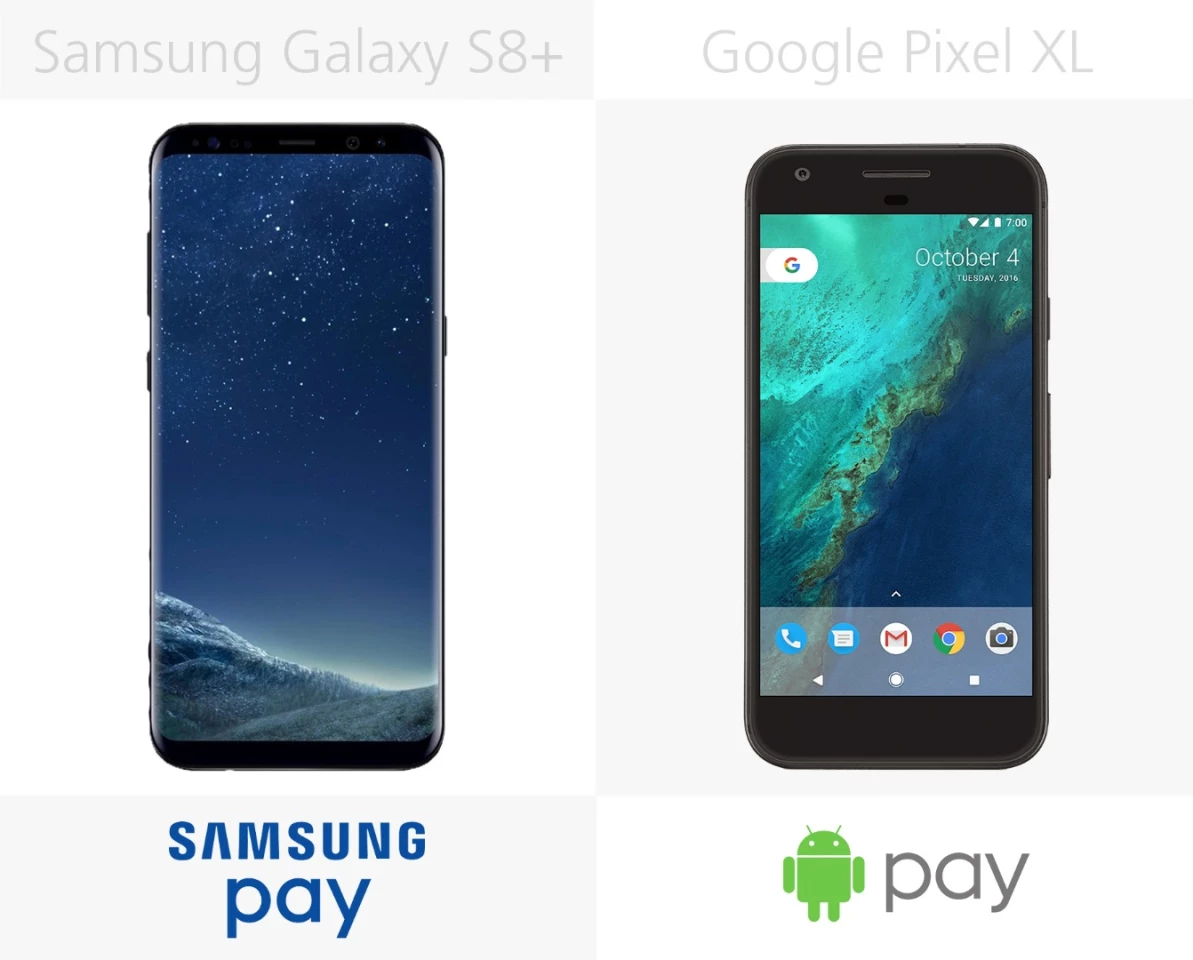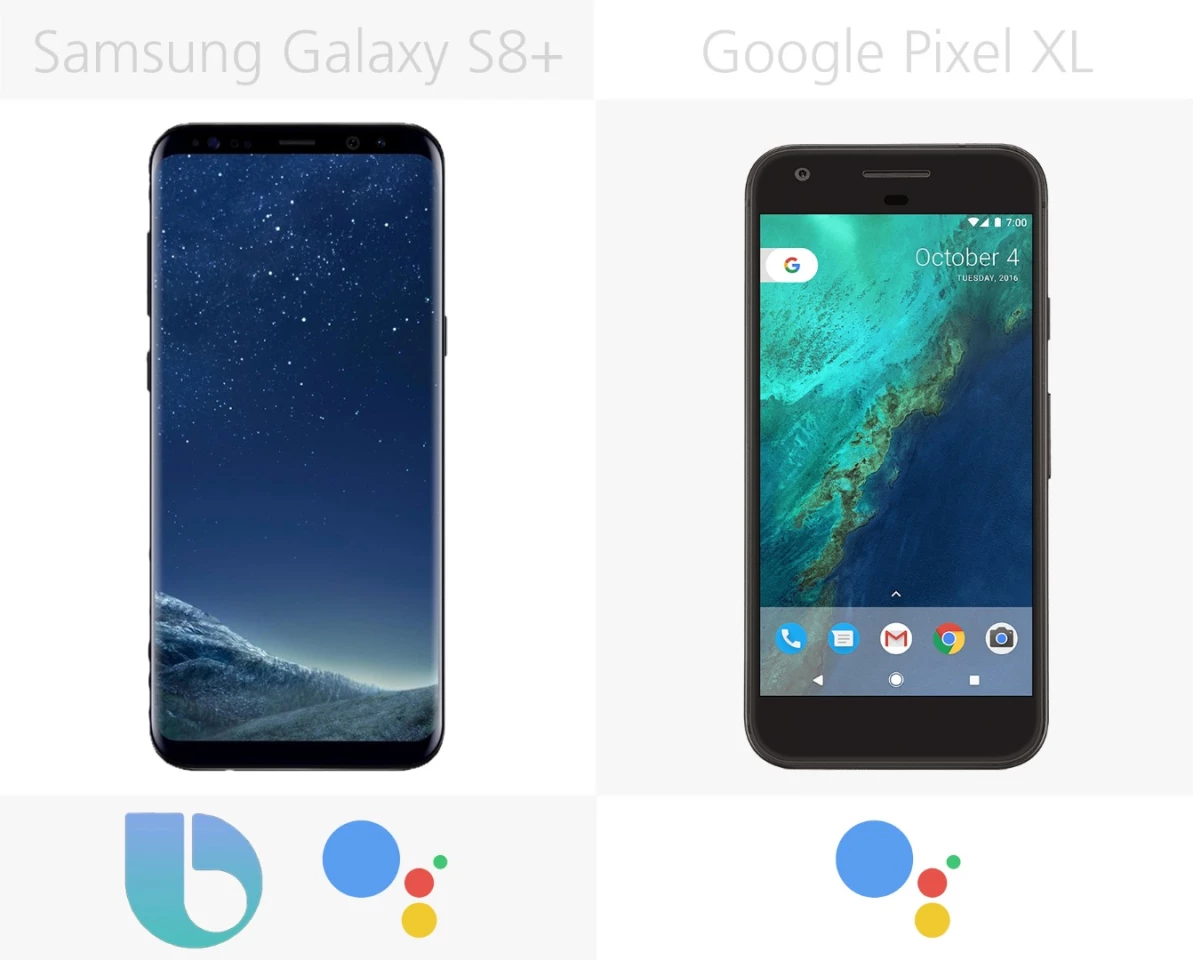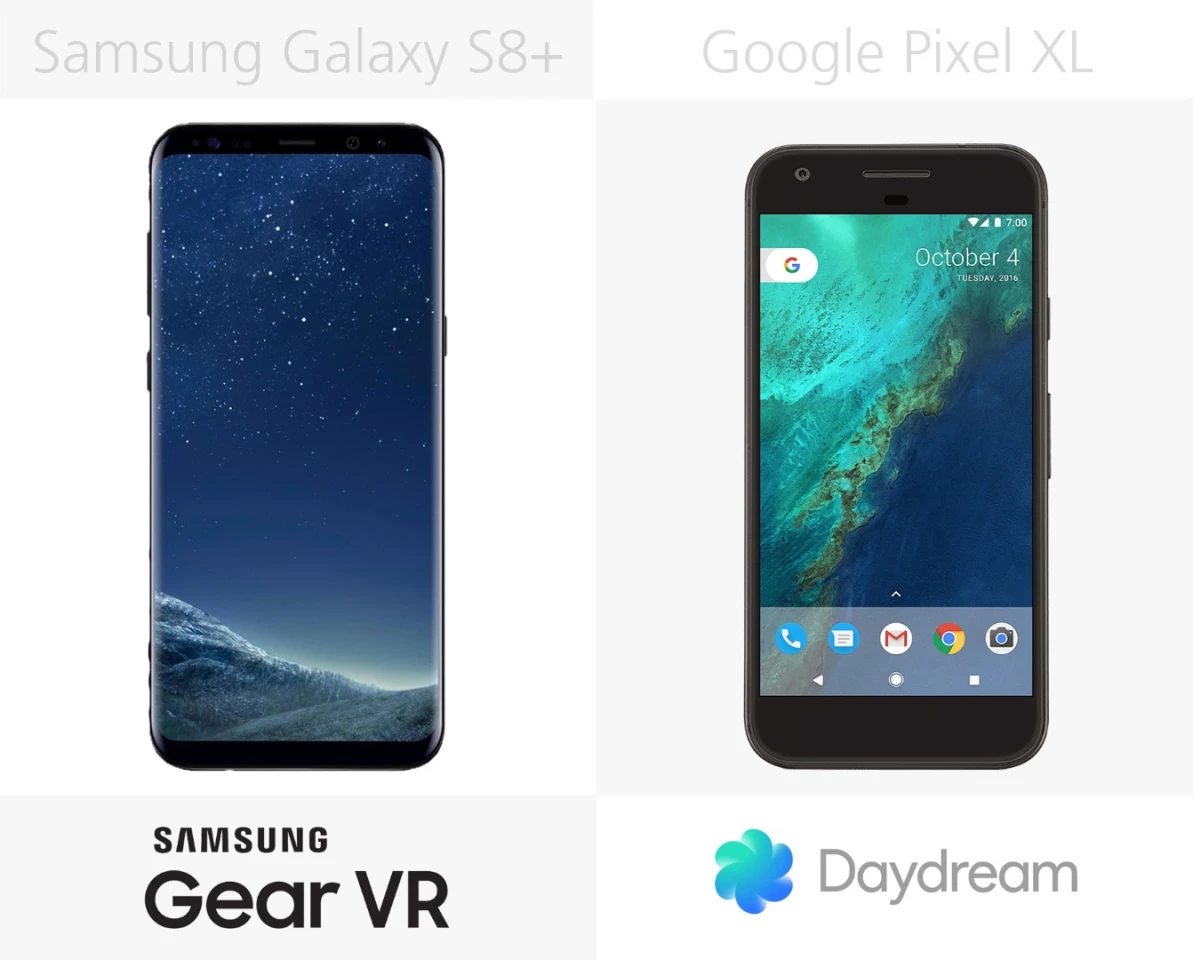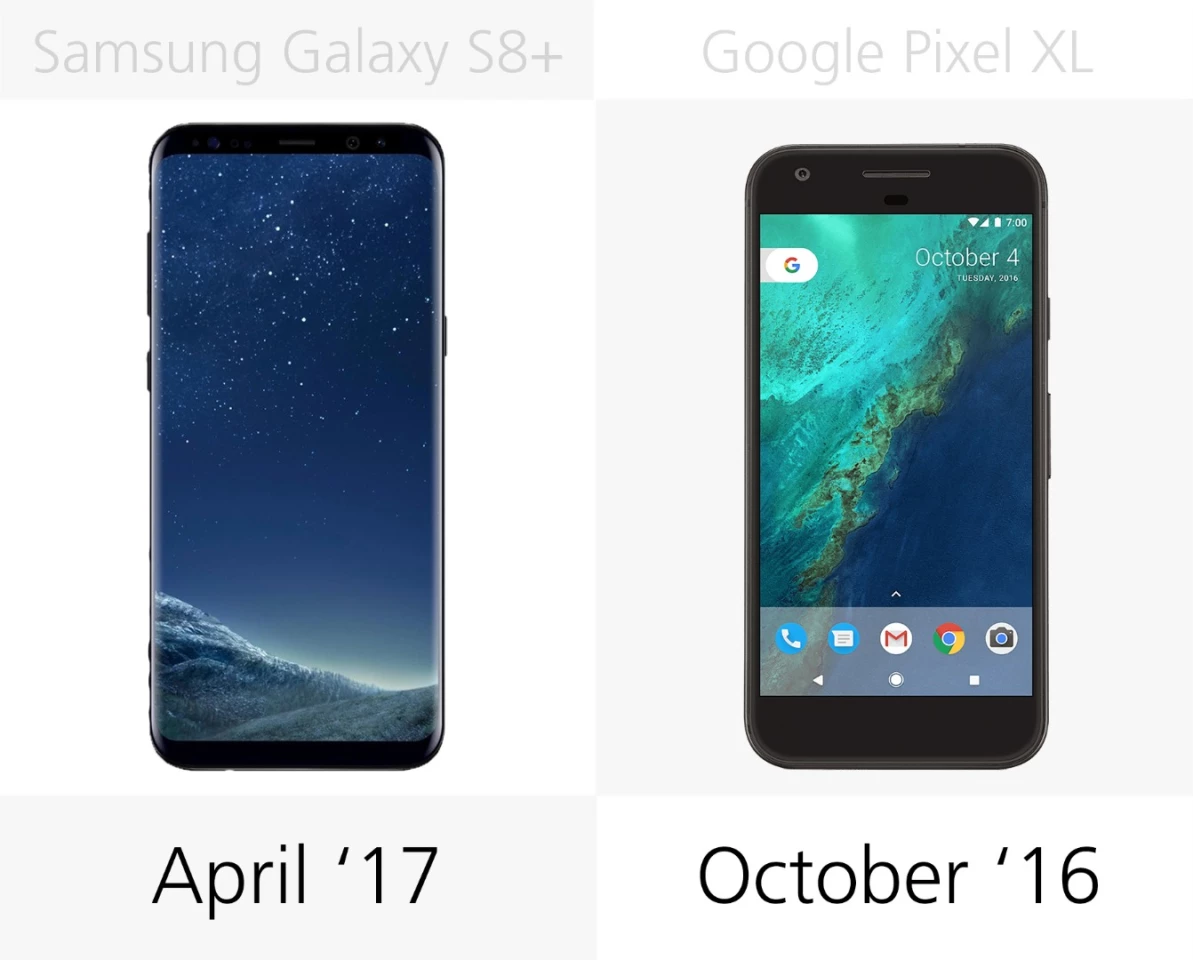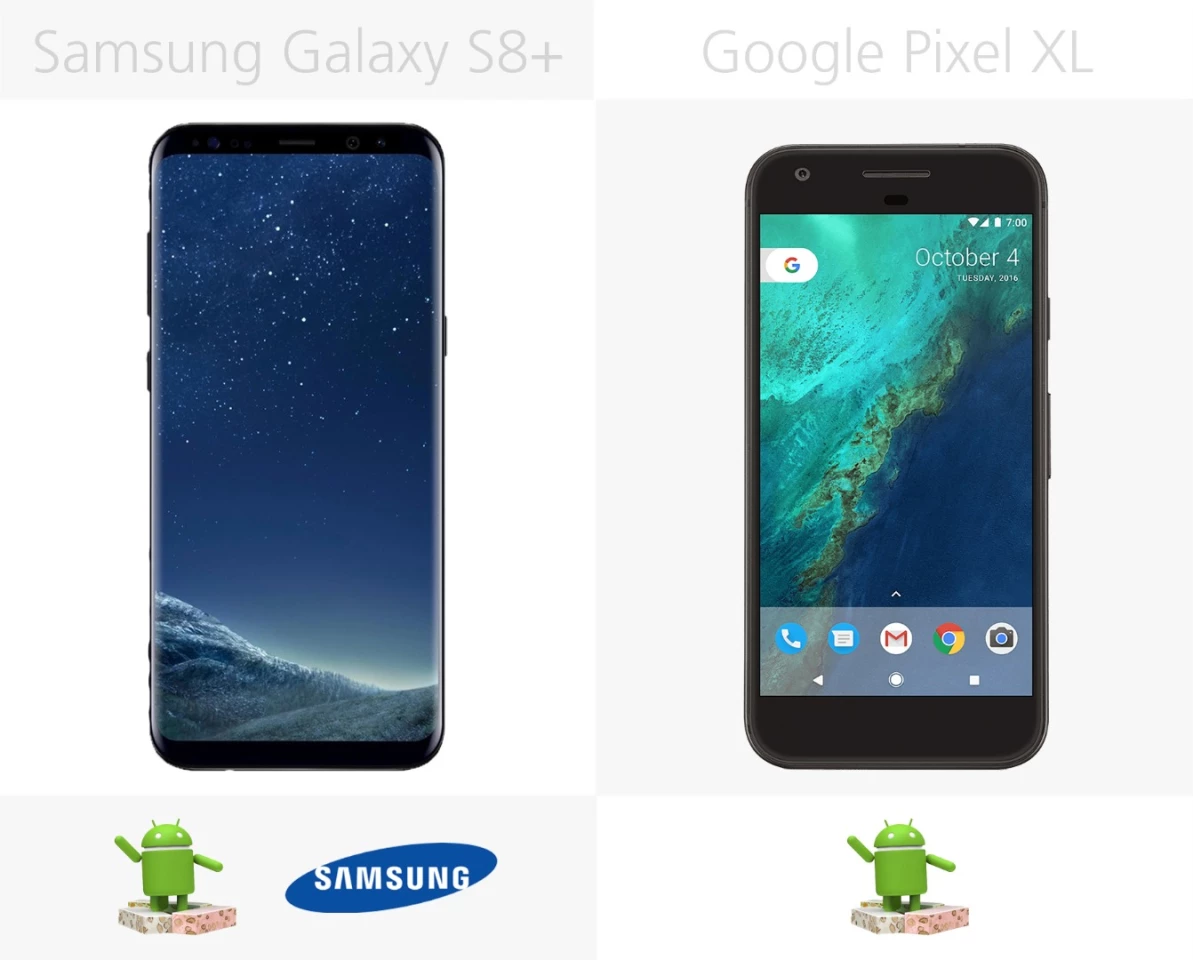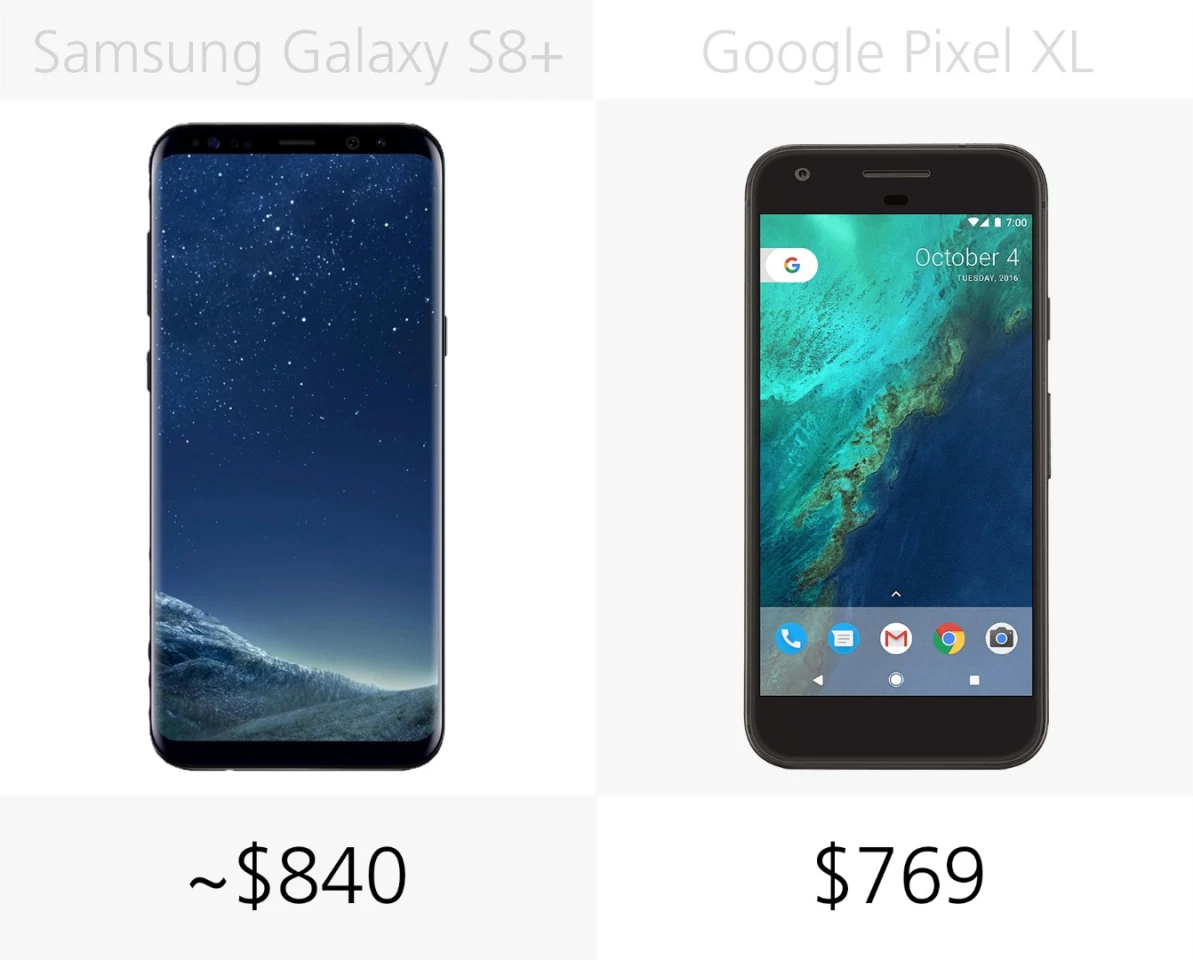The Google Pixel XL was one of our favorite phones of 2017, but Samsung's Galaxy S8+ flagship is shaping up to be quite impressive. Let's take a look at how the specs and features of the Pixel XL measure up against those of Samsung's latest top-of-the-line phone.
Size
The Galaxy S8+ is 3-percent taller, 4-percent narrower and nearly 10-percent thicker than the Pixel XL.
Weight
The S8+ is also about 5-percent heavier, but keep in mind that difference is about the weight of a nickel.
Build materials
Both phones have glass and aluminum builds, but to very different effects. The Samsung flagship has a curved glass back with a thin aluminum frame. The Google Pixel has an aluminum back and frame with a glass accent panel on the upper back.
Colors
Samsung showcased five different colors for the S8 flagships at the launch event, but only black, silver and orchid gray will be available to US customers at launch. The Pixel comes in black, silver and blue.
Water resistance
Samsung offers industry-topping water resistance ratings in its S8 series flagships. Google does not offer similar protection.
Display size
The so-called Infinity Display is the crowning feature of the Galaxy S8 series. The large, rounded display covers nearly the entire front side of the Samsung phone. Overall, the S8+ packs in 17-percent more screen space than the already-large Pixel XL.
Display resolution
The Pixel XL is one of the few flagships that bests the S8+ display (albeit slightly) in pixel density. With that said, DisplayMate named the Galaxy S8 as the phone with the best display.
Display type
Both makers opt for AMOLED display technology over IPS.
HDR display
Samsung's S8 series are the first phones to receive the Mobile HDR Premium certification from the UHD Alliance. Amongst other details, that means the S8+ can support HDR content. No such luck with the Pixel XL.
Curved display
The Galaxy S8+'s display is curved, wrapping around the rounded edges of the phone. Like most phones, the display on the Pixel XL is flat.
Home button
Both phones have onscreen home buttons. At the S8+ launch event, Samsung described pressure-sensitive technology in the home button that could mean it contains some navigational shortcuts. We couldn't see much evidence of this during our brief hands-on time, but we'll investigate further in our full-length review.
Fingerprint sensor
Both phones have a back-mounted fingerprint sensor. On the S8+, it's to the right of the camera. It's centered on the back of the Pixel XL.
Face recognition
The S8+ has face recognition capabilities for quick log-ins. However, it may not be the most secure of the biometric access methods.
Iris scanning
If fingerprint scanning or face recognition doesn't suit your needs, the Galaxy S8+ offers yet another option: iris scanning.
Processor
Samsung uses the latest Snapdragon 835 processor in the US and other markets. Elsewhere, the S8+ contains Samsung's own Exynos 8895 chip. The Pixel XL has last year's Snapdragon 821 chip, which clocks at lower speeds but is certainly still competitive.
RAM
Both phones contain 4 GB of RAM.
Storage
When it comes to internal storage, Samsung offers one 64 GB option for the S8+, while the Pixel XL is available with 32 GB or 128 GB.
MicroSD
If space is an issue for you, Samsung still has you better covered: The S8+ has a microSD slot for expandable storage.
Headphone jack
To be clear, neither of these phone follow in the footsteps of the iPhone 7/7 Plus: The traditional headphone jack remains.
Bundled headphones
In most markets, the Pixel phones do not ship with headphones. However, the S8+ is bundled with a pair of wired AKG earbuds that retail on their own for US$99.
Battery
The S8+ has a slightly larger battery, but that's not enough to indicate which phone has more staying power overall. We'll put the S8+ to the test in our full-length review.
Wireless charging
The S8+ supports wireless charging (with a sold-separately charging pad). It even offers some fast wireless charging capacity.
Fast charging
Both phones offer fast wired charging, but to different standards. According to Google, the USB-C quick charge technology on the Pixel XL can get up to 4 hours of use from 15 minutes of charging.
We're still waiting for confirmation of which Qualcomm Quick Charge standard the S8 series supports. Its Snapdragon 835 chip supports Quick Charge 4.0, but that doesn't necessarily mean it will be supported and usable at launch.
Camera megapixels
This pair of phones has matching camera megapixels: 12 MP in the rear camera, 8 MP in the front (selfie) camera.
Camera aperture (rear)
The S8+ has a bigger aperture, which means more light can access the imaging sensor. This could add perks like better low-light snaps and/or improved depth-of-field effects.
Dual-lens camera
Neither of these makers opted for a trendy dual-lens camera system.
OIS
The S8+ includes OIS (optical image stabilization) to combat picture blur that comes from shaky hands. The Pixel XL does not have OIS, but to be fair, we don't miss it much in its excellent camera: Google uses multi-image processing to achieve outstanding results with (in some ways) lesser camera hardware.
Mobile payments
The S8+ supports Samsung Pay, which can be used with NFC or magnetic strip readers, so it could potentially be accepted at more places. Android Pay requires merchants to have an NFC terminal.
Voice assistant
In addition to Google Assistant, the Galaxy S8 series phones debut Samsung's own Bixby. While we doubt that virtual assistants are a major driving force behind smartphone sales at this point, hardware and software manufacturers are certainly pouring lots of energy and effort into them.
Unfortunately Samsung recently announced that Bixby will launch without voice control – its most important feature – enabled in the US version.
Virtual reality headset
These two flagships support full-fledged mobile VR (not just Google Cardboard and its variations).
The S8+ works with the Samsung Gear VR, while the Pixel XL is Google Daydream-ready. Both are similarly capable headsets, but at this point, the Gear VR has a more alluring content library.
Desktop dock
At the S8 launch event, Samsung unveiled the DeX dock (sold separately), which allows you to power a desktop-like computing experience using an S8 series phone.
Release
The Pixel XL launched in October 2016, but the S8+ hits shelves later this month.
Software
Since the Pixel XL is a made-by-Google phone, it runs pure Android and is first in line for software updates in the near future.
The S8+ also runs the latest version of the Android operating system (Android Nougat), but skins it with Samsung's TouchWiz UI.
Starting price (full retail)
As is typical for Samsung phones, pricing for the Galaxy S8+ depends on carrier and payment plan. Still, it's one of the most expensive flagships on the market. When all is said and done, count on paying around US$840. Meanwhile, the Pixel XL starts at $769, the same price as an iPhone 7 Plus.
For more hands-on information, check out our impressions of the Samsung Galaxy S8+ from the launch event, or our review of the Google Pixel XL.
If you're also considering smaller, less expensive phones, you could opt for either the Galaxy S8 or the Google Pixel. However, the drop from the Pixel XL to the Pixel marks a more significant downgrade than the difference between the Galaxy S8+ and the S8, which share many of the same specs.



